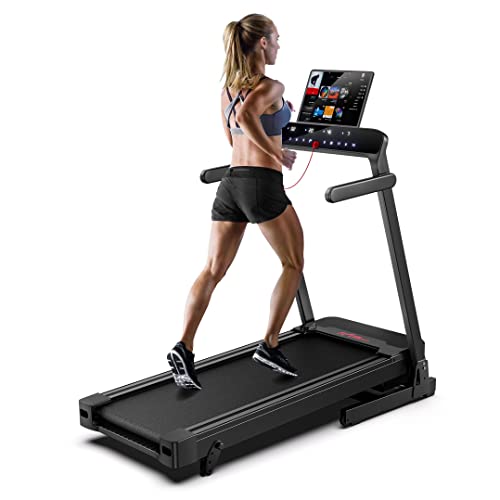The Most Worst Nightmare Concerning Tread Mill It's Coming To Life
Treadmills: A Comprehensive Guide to Understanding Their Functionality, Benefits, and Appropriate Selection
Intro
Treadmills have become a staple in modern physical fitness routines, both in homes and health clubs worldwide. They provide a practical and effective method to maintain cardiovascular health, increase endurance, and help in weight management. This article explores the different kinds of treadmills, their benefits, functions to think about when purchasing, and some FAQs to assist users in making notified decisions.
Types of Treadmills
When it pertains to selecting a treadmill, it is crucial to comprehend the various types readily available in the market. Here are the primary classifications:
1. Manual Treadmills
- Mechanism: These treadmills have a basic style and count on the user's efforts to move the belt.
- Pros: More inexpensive, quieter operation, no electricity required.
- Cons: Limited features, might not offer the very same variety of exercise intensity.
2. Motorized Treadmills
- System: Powered by a motor that drives the belt, enabling users to walk or perform at a set speed.
- Pros: Greater range of speeds and slopes, equipped with various functions such as heart rate displays and workout programs.
- Cons: More costly and may need more maintenance.
3. Folding Treadmills
- System: Designed for those with restricted area, these treadmills can be folded for simple storage.
- Pros: Space-saving, typically motorized, versatile features.
- Cons: May be less durable than non-folding designs.
4. Business Treadmills
- Mechanism: High-quality machines developed for use in gyms and physical fitness centers.
- Pros: Built to stand up to heavy use, advanced functions, frequently include service warranties.
- Cons: Pricey and not ideal for home use due to size.
5. Curved Treadmills
- Mechanism: A distinct design that permits users to propel the belt using their own energy.
- Pros: Offers a more natural running experience, promotes much better running type.
- Cons: More expensive and can be noisier.
Treadmill Type
Pros
Cons
Manual
Economical, no electrical energy required
Minimal features
Motorized
Range of speeds, advanced functions
Maintenance required
Folding
Space-saving, frequently motorized
May do not have toughness
Commercial
Constructed to last, professional-grade functions
Expensive
Curved
Natural running experience, promotes good kind
Greater cost
Benefits of Using Treadmills
Treadmills provide various advantages that can contribute to one's total fitness objectives. A few of these advantages include:
- Convenient Workouts: Treadmills allow users to exercise inside your home regardless of weather conditions.
- Cardiovascular Health: Regular use can improve heart health by increasing endurance and promoting healthy blood circulation.
- Weight Management: Effective for burning calories, which helps in weight reduction and management.
- Adjustable Workouts: Users can manage speed, incline, and duration to develop tailored workout experiences.
- Safety: Treadmills provide a predictable surface, minimizing the threat of falls compared to outside running.
- Multifunctional: Many treadmills featured features like heart rate monitors, workout programs, and even entertainment systems.
Picking the Right Treadmill
When selecting a treadmill, prospective purchasers need to consider numerous crucial elements:
Features to Consider:
- Motor Power: Typically measured in horsepower (HP), a motor strength of a minimum of 2.5 HP is advised for major runners.
- Belt Size: A longer and wider belt accommodates various stride lengths, providing comfort throughout workouts.
- Incline Settings: Adjustable slope functions mimic outside hill running and can increase workout strength.
- Weight Capacity: Ensure the treadmill can support the user's weight for safety and durability.
- Console Features: Look for easy to use control panels, exercise programs, and Bluetooth compatibility for streaming music or other functions.
Budget plan Considerations
- Under ₤ 500: Entry-level manual treadmills appropriate for casual walkers.
- ₤ 500 – ₤ 1,500: Mid-range motorized treadmills that use more functions and much better durability.
- ₤ 1,500 – ₤ 3,000: High-end designs with innovative innovation, larger motors, and longer warranties.
- Over ₤ 3,000: Commercial-grade treadmills perfect for regular usage in fitness centers or training centers.
Frequently Asked Questions (FAQs)
1. How often should I utilize a treadmill?
It is advised to use a treadmill a minimum of 3 to 5 times a week, incorporating different intensity levels for best results.
2. Can angleanyce.top drop weight by utilizing a treadmill?
Yes, constant use of a treadmill can contribute to weight-loss, particularly when integrated with a balanced diet plan and strength training.
3. What is the very best speed to stroll on a treadmill for novices?
A speed of 3 to 4 miles per hour is an ideal variety for beginners. It's vital to begin slow and gradually increase rate as comfort and stamina enhance.
4. Do I need to utilize a treadmill if I currently run outdoors?
Utilizing a treadmill can offer additional advantages, such as controlled environments and differed workouts (incline, intervals) that are not constantly possible outdoors.
5. How do I maintain my treadmill?
Regular maintenance includes lubricating the belt, cleaning the deck and console, and inspecting the motor for optimal efficiency.
Treadmills are necessary tools for those seeking to enhance their fitness levels in a regulated and convenient way. With various types offered, understanding their features and benefits is crucial for making an informed purchase. By thinking about individual workout requirements, space accessibility, and spending plan constraints, individuals can find the most ideal treadmill that fits their way of life. Incorporating treadmill workouts into a well balanced fitness regimen can cause improved health results and an enjoyable exercise experience.
